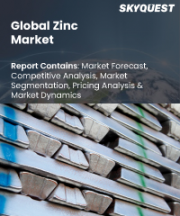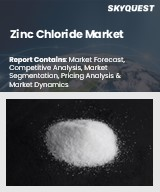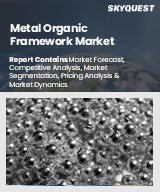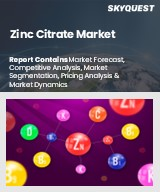
|
시장보고서
상품코드
1775668
아연 시장 규모, 점유율, 성장 분석 : 형태별, 채굴 유형별, 판매채널별, 용도별, 최종 용도별, 지역별 - 산업 예측(2025-2032년)Zinc Market Size, Share, and Growth Analysis, By Form (Powder, Sheet), By Mining Type (Underground Mining, Surface Mining), By Sales Channel, By Application, By End Use, By Region - Industry Forecast 2025-2032 |
||||||
세계의 아연 시장 규모는 2023년에 253억 달러에 달하며, 예측 기간(2025-2032년)의 CAGR은 7.5%로, 2024년 272억 달러에서 2032년에는 485억 1,000만 달러로 성장할 전망입니다.
아연 세계 시장은 건설, 자동차, 전자 등 다양한 분야에서 중요한 역할을 반영하여 강력한 성장과 고유한 변동성을 특징으로 합니다. 이 필수 금속은 도시화, 인프라 계획, 아연 도금 강판에 대한 수요 증가를 원동력으로 경제 발전을 지원하고 있습니다. 이러한 성장에도 불구하고 시장은 가격 변동, 지정학적 긴장, 엄격한 환경 규제 등의 문제에 직면해 있습니다. 중국은 세계 시장 상황에서 압도적인 소비국이자 생산국으로 부상하여 상당한 시장 점유율을 차지하고 있습니다. 다른 주요 기여국으로는 미국, 인도, 유럽 국가 등이 있으며, 이들 국가는 모두 세계 아연 시장 역학에 중요한 역할을 하고 있습니다. 이 복잡한 산업을 주도하고자 하는 이해관계자들에게 이러한 동향을 이해하는 것은 필수적입니다.
목차
서론
- 조사의 목적
- 조사 범위
- 정의
조사 방법
- 정보 조달
- 2차와 1차 데이터 방법
- 시장 규모 예측
- 시장의 전제조건과 제한
개요
- 세계 시장 전망
- 공급과 수요 동향 분석
- 부문별 기회 분석
시장 역학과 전망
- 시장 개요
- 시장 규모
- 시장 역학
- 촉진요인과 기회
- 억제요인과 과제
- Porter의 산업 분석
주요 시장 인사이트
- 주요 성공 요인
- 경쟁의 정도
- 주요 투자 기회
- 시장 에코시스템
- 시장의 매력 지수(2024년)
- PESTEL 분석
- 거시경제 지표
- 밸류체인 분석
- 가격 분석
- 사례 연구
- 고객 구매 행동 분석
아연 시장 규모 : 형태별 & CAGR(2025-2032)
- 시장 개요
- 분말
- 시트
아연 시장 규모 : 채굴 유형별 & CAGR(2025-2032)
- 시장 개요
- 지하 채굴
- 노천 채굴
아연 시장 규모 : 판매채널별 & CAGR(2025-2032)
- 시장 개요
- 직접 판매
- 간접 판매
아연 시장 규모 : 용도별 & CAGR(2025-2032)
- 시장 개요
- 아연 도금
- 다이캐스트
- 황동
- 산화물과 화학물질
- 기타 용도
아연 시장 규모 : 최종 용도별 & CAGR(2025-2032)
- 시장 개요
- 건설
- 운송
- 소비재
- 전기화 제품
- 일반 공학
아연 시장 규모 : 지역별 & CAGR(2025-2032)
- 북미
- 미국
- 캐나다
- 유럽
- 독일
- 스페인
- 프랑스
- 영국
- 이탈리아
- 기타 유럽 지역
- 아시아태평양
- 중국
- 인도
- 일본
- 한국
- 기타 아시아태평양
- 라틴아메리카
- 브라질
- 기타 라틴아메리카 지역
- 중동 및 아프리카
- GCC 국가
- 남아프리카공화국
- 기타 중동 및 아프리카
경쟁 정보
- 상위 5사의 비교
- 주요 기업의 시장 포지셔닝(2024년)
- 주요 시장 기업이 채택한 전략
- 최근 시장 동향
- 기업의 시장 점유율 분석(2024년)
- 주요 기업의 기업 개요
- 기업의 상세
- 제품 포트폴리오 분석
- 기업의 부문별 점유율 분석
- 매출의 전년대비 비교(2022-2024년)
주요 기업 개요
- Boliden Group
- Glencore
- Grupo Mexico
- Hindustan Zinc
- Koreazinc
- MMG Australia Limited
- Teck Resources Limited
- Vedanta Resources Limited
- Zochem, Inc
- Old Bridge Chemicals
결론과 제안
KSA 25.07.31Global Zinc Market size was valued at USD 25.3 billion in 2023 and is poised to grow from USD 27.2 billion in 2024 to USD 48.51 billion by 2032, growing at a CAGR of 7.5% during the forecast period (2025-2032).
The global zinc market is characterized by robust growth and inherent volatility, reflecting its critical role across diverse sectors such as construction, automotive, and electronics. This essential metal supports economic advancement, driven by urbanization, infrastructure initiatives, and a rising demand for galvanized steel. Despite this growth, the market contends with challenges including price fluctuations, geopolitical tensions, and stringent environmental regulations. China emerges as the predominant consumer and producer within the global zinc landscape, holding a substantial market share. Other key contributors include the United States, India, and various European nations, all of which play significant roles in shaping the dynamics of the zinc market worldwide. Understanding these trends is vital for stakeholders aiming to navigate this complex industry.
Top-down and bottom-up approaches were used to estimate and validate the size of the Global Zinc market and to estimate the size of various other dependent submarkets. The research methodology used to estimate the market size includes the following details: The key players in the market were identified through secondary research, and their market shares in the respective regions were determined through primary and secondary research. This entire procedure includes the study of the annual and financial reports of the top market players and extensive interviews for key insights from industry leaders such as CEOs, VPs, directors, and marketing executives. All percentage shares split, and breakdowns were determined using secondary sources and verified through Primary sources. All possible parameters that affect the markets covered in this research study have been accounted for, viewed in extensive detail, verified through primary research, and analyzed to get the final quantitative and qualitative data.
Global Zinc Market Segments Analysis
Global Zinc Market is segmented by Form, Mining Type, Sales Channel, Application, End Use and region. Based on Form, the market is segmented into Powder and Sheet. Based on Mining Type, the market is segmented into Underground Mining and Surface Mining. Based on Sales Channel, the market is segmented into Direct Sale and Indirect Sale. Based on Application, the market is segmented into Galvanizing, Die casting, Brass, Oxide & chemicals and Other Applications. Based on End Use, the market is segmented into Construction, Transport, Consumer Goods, Electrical Appliances and General Engineering. Based on region, the market is segmented into North America, Europe, Asia Pacific, Latin America and Middle East & Africa.
Driver of the Global Zinc Market
The Global Zinc market is significantly influenced by the diverse applications of zinc across various industries, including construction, infrastructure, automotive, and electrical equipment. As emerging economies experience growth and development, the demand for zinc continues to escalate, driven by factors such as expanding infrastructure projects, rapid urbanization, and improving disposable incomes. These elements collectively fuel the industrial need for zinc, highlighting its critical role in supporting advancements within these key sectors. The ongoing evolution of these industries reinforces the essential position of zinc in meeting the demands of a constantly advancing global economy.
Restraints in the Global Zinc Market
The global zinc market faces significant challenges due to its susceptibility to price volatility. This volatility is driven by multiple factors, including the balance of supply and demand, overall economic conditions worldwide, geopolitical developments, and speculative trading activities. As a result, both producers and consumers may find it difficult to devise long-term investment strategies due to unpredictable price shifts. Such fluctuations can impact profit margins and generate a climate of uncertainty, hindering the decision-making processes of market participants and complicating their ability to navigate the evolving landscape of the zinc sector.
Market Trends of the Global Zinc Market
The Global Zinc market is experiencing a robust trend driven by several interrelated factors. The transition to renewable energy sources has significantly boosted zinc demand, especially for applications in solar panels and wind turbines, alongside the growing electric vehicle sector, which necessitates zinc for battery production. Additionally, a heightened emphasis on sustainability is prompting mining companies to implement cleaner extraction methods and enhance recycling efforts, driven by regulatory pressures and environmental concerns. Geopolitical dynamics, including trade tensions and supply chain disruptions, further complicate market conditions, impacting prices and availability. Collectively, these trends signify a strong growth trajectory for the zinc market, shaped by innovation, sustainability, and global economic factors.
Table of Contents
Introduction
- Objectives of the Study
- Scope of the Report
- Definitions
Research Methodology
- Information Procurement
- Secondary & Primary Data Methods
- Market Size Estimation
- Market Assumptions & Limitations
Executive Summary
- Global Market Outlook
- Supply & Demand Trend Analysis
- Segmental Opportunity Analysis
Market Dynamics & Outlook
- Market Overview
- Market Size
- Market Dynamics
- Drivers & Opportunities
- Restraints & Challenges
- Porters Analysis
- Competitive rivalry
- Threat of substitute
- Bargaining power of buyers
- Threat of new entrants
- Bargaining power of suppliers
Key Market Insights
- Key Success Factors
- Degree of Competition
- Top Investment Pockets
- Market Ecosystem
- Market Attractiveness Index, 2024
- PESTEL Analysis
- Macro-Economic Indicators
- Value Chain Analysis
- Pricing Analysis
- Case Studies
- Customer Buying Behavior Analysis
Global Zinc Market Size by Form & CAGR (2025-2032)
- Market Overview
- Powder
- Sheet
Global Zinc Market Size by Mining Type & CAGR (2025-2032)
- Market Overview
- Underground Mining
- Surface Mining
Global Zinc Market Size by Sales Channel & CAGR (2025-2032)
- Market Overview
- Direct Sale
- Indirect Sale
Global Zinc Market Size by Application & CAGR (2025-2032)
- Market Overview
- Galvanizing
- Die casting
- Brass
- Oxide & chemicals
- Other Applications
Global Zinc Market Size by End Use & CAGR (2025-2032)
- Market Overview
- Construction
- Transport
- Consumer Goods
- Electrical Appliances
- General Engineering
Global Zinc Market Size & CAGR (2025-2032)
- North America (Form, Mining Type, Sales Channel, Application, End Use)
- US
- Canada
- Europe (Form, Mining Type, Sales Channel, Application, End Use)
- Germany
- Spain
- France
- UK
- Italy
- Rest of Europe
- Asia Pacific (Form, Mining Type, Sales Channel, Application, End Use)
- China
- India
- Japan
- South Korea
- Rest of Asia-Pacific
- Latin America (Form, Mining Type, Sales Channel, Application, End Use)
- Brazil
- Rest of Latin America
- Middle East & Africa (Form, Mining Type, Sales Channel, Application, End Use)
- GCC Countries
- South Africa
- Rest of Middle East & Africa
Competitive Intelligence
- Top 5 Player Comparison
- Market Positioning of Key Players, 2024
- Strategies Adopted by Key Market Players
- Recent Developments in the Market
- Company Market Share Analysis, 2024
- Company Profiles of All Key Players
- Company Details
- Product Portfolio Analysis
- Company's Segmental Share Analysis
- Revenue Y-O-Y Comparison (2022-2024)
Key Company Profiles
- Boliden Group
- Company Overview
- Business Segment Overview
- Financial Updates
- Key Developments
- Glencore
- Company Overview
- Business Segment Overview
- Financial Updates
- Key Developments
- Grupo Mexico
- Company Overview
- Business Segment Overview
- Financial Updates
- Key Developments
- Hindustan Zinc
- Company Overview
- Business Segment Overview
- Financial Updates
- Key Developments
- Koreazinc
- Company Overview
- Business Segment Overview
- Financial Updates
- Key Developments
- MMG Australia Limited
- Company Overview
- Business Segment Overview
- Financial Updates
- Key Developments
- Teck Resources Limited
- Company Overview
- Business Segment Overview
- Financial Updates
- Key Developments
- Vedanta Resources Limited
- Company Overview
- Business Segment Overview
- Financial Updates
- Key Developments
- Zochem, Inc
- Company Overview
- Business Segment Overview
- Financial Updates
- Key Developments
- Old Bridge Chemicals
- Company Overview
- Business Segment Overview
- Financial Updates
- Key Developments



















